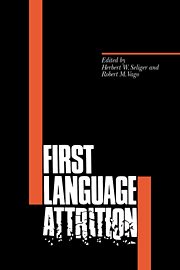Book contents
- Frontmatter
- Contents
- List of figures
- List of tables
- List of contributors
- Acknowledgment
- Part I Survey studies
- 1 The study of first language attrition: an overview
- 2 First language attrition and the parameter setting model
- 3 Recapitulation, regression, and language loss
- 4 First language loss in bilingual and polyglot aphasics
- 5 A crosslinguistic study of language contact and language attrition
- Part II Group studies
- Part III Case studies
- Index
4 - First language loss in bilingual and polyglot aphasics
Published online by Cambridge University Press: 14 January 2010
- Frontmatter
- Contents
- List of figures
- List of tables
- List of contributors
- Acknowledgment
- Part I Survey studies
- 1 The study of first language attrition: an overview
- 2 First language attrition and the parameter setting model
- 3 Recapitulation, regression, and language loss
- 4 First language loss in bilingual and polyglot aphasics
- 5 A crosslinguistic study of language contact and language attrition
- Part II Group studies
- Part III Case studies
- Index
Summary
Introduction
It is generally understood that one will lose facility even in one's first language if it is not used for a long enough period. As the Russian–French bilingual writer Triolet puts it vividly, “You cannot keep [a language] safe deep within you, it must get some exercise. You must use it, or else it gets rusty, atrophies and dies”. To complement the growing literature on second language (L2) attrition, a literature on first language (L1) attrition is developing. Several populations are of interest in considering the question of first language loss or diminishment: healthy bilingual individuals with reduced practice in their L1 (e.g. the study of Olshtain & Barzilay 1987), demented bilinguals (as in Hyltenstam & Stroud 1989; DeSanti, Obler, Abramson, & Goldberger 1989) and aphasics.
Indeed, the primary source of data in neurolinguistics has been the study of aphasics, individuals with brain damage resulting in language disturbance. Thus it is to bilingual and polyglot aphasics that we turn for converging evidence on loss of the first language. In previous work we have discussed the phenomena that predict various of the differential recovery patterns in aphasia (Albert & Obler 1978; Obler & Albert 1977; also see Paradis 1977 for a classification of differential recovery patterns). In particular we determined that for the group of polyglot aphasics as a whole, it is the rule proposed by Pitres in 1895 that holds: in the event that only one language returns, it is most likely to be the language that was being used around the time of the accident, rather than, for example, always being the first learned language.
- Type
- Chapter
- Information
- First Language Attrition , pp. 53 - 66Publisher: Cambridge University PressPrint publication year: 1991
- 3
- Cited by



